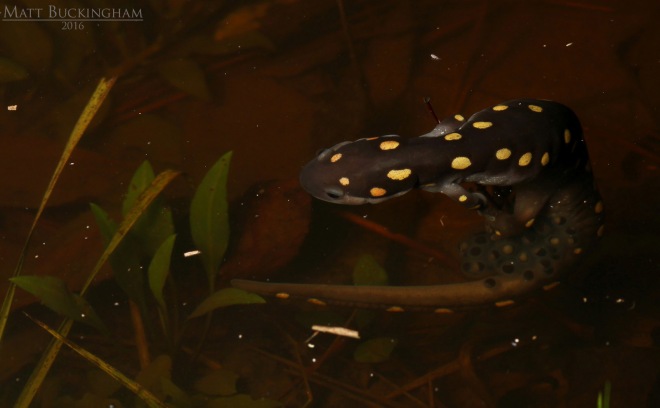
Ovipositing Spotted Salamander
There are few things more magical, few moments more memorable, and few experiences more rewarding than exploring a vernal pool in late winter and early spring. I wish everyone could know the joy that I feel standing ankle deep in the frigid water amid a deafening cacophony of Spring Peepers and chorus frogs.
Vernal pools are isolated wetlands that form in upland depressions. In the great forests of the eastern United States, of which the Pineywoods of East Texas are essentially an extension, they often occur in open, mature forests over pockets of dense clay scattered among a matrix of otherwise loamy soil. They may also occur in the scars of old stream beds left after some waterway changed course millennia ago. The unique topography of these areas result in pools that hold water during the winter and spring and dry in the summer and fall.

A dry vernal pool in fall
Vernal pools begin to fill in the late fall and early winter with the return of regular rainfall patterns associated with frequent fronts. At the same time trees and other plants are entering a period of dormancy, when their water requirements are reduced dramatically. This reduction in plant activity results in a rising of the water table. In more northerly climates the pools may not fill until the spring snow melt funnels water to them. By later spring and early summer, the water table begins to drop as thirsty roots draw from it. Evapotranspiration increases, and by late summer these depressions will be dry as a bone.
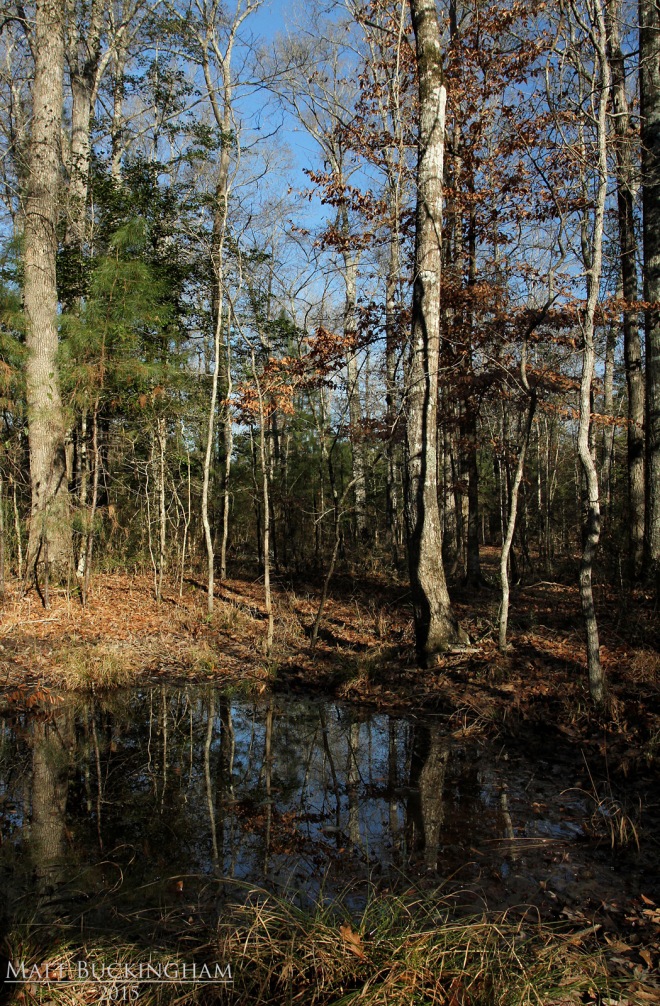
A full vernal pool in late winter
The ephemeral nature of these wetlands means that fish are unable to survive here. This does not mean that vernal pools are devoid of life, however. A multitude of invertebrates specialize in vernal pools and a spectacular array of amphibians depend on them to breed. It is, in fact, the absence of fish that allow these organisms to thrive here. Without these voracious piscene predators, and with an abundance of invertebrate prey, amphibian larvae can flourish.
Many amphibians typical of eastern North America reach the southwestern extend in East Texas. Most of these species breed during the first substantial warm rains of late winter and early spring, often undergoing mass migrations from upland refugia to reach the vernal pools. Easily the most spectacular of these amphibians, and perhaps my favorite animal of all time, is the Spotted Salamander (Ambystoma maculatum). These large, brightly colored members of the family Ambystomatidae are like the “poster children” of vernal pools. Their fate is so closely tied to these unique habitats that they are indicator species for them. And as healthy vernal pools depend on a healthy, mature forest, the Spotted Salamander is, in turn, an indicator species for the health of the entire forest.
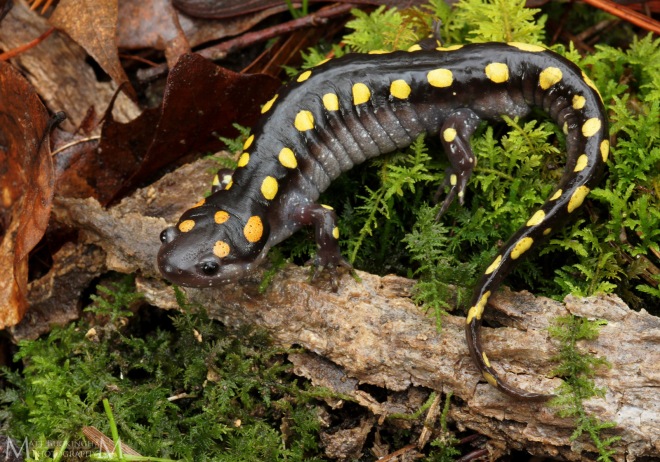
A male Spotted Salamander
Spotted salamanders spend the majority of their lives confined to small burrows, generally excavated by some species of rodent or other fossorial creature. As the warm winter rains begin to saturate the soil they slowly emerge from their underground haunts and make their way, en masse, to the vernal pools of their birth. The males arrive first. They can be identified this time of year by their swollen cloacas. When all is said and done they will outnumber the females several to one. After entering the water they dutifully set out to find the perfect spot to deposit their spermatophore, a gelatinous deposit containing their genetic material. Here they await the arrival of the females.

A Spotted Salamander emerges from the leaf litter
When the females do arrive their are swollen with a gelatinous mass of eggs within. The males dance and display around their spermatophore with a series of flips, gyrations, and underwater acrobatics. Once they have caught the eye of a female they gently guide her over their spermatophore. She picks it up with her cloaca and uses it to fertilize her eggs. She then deposits an impossibly massive egg mass on a submerged twig or vegetation. The salamanders do not dawdle in the ponds, and as soon as they arrived they return to their upland burrows. Here they will remain for the rest of the year. Part of what makes seeing a Spotted Salamander so special is knowing that they are only visible to the above-ground world for a few shorts weeks of the year.
The salamander eggs are protected by a thick gelatinous mass that is resistant to desiccation should the pool dry for a short time during their development. The Spotted Salamander have a mutualistic relationship with an algae, Oophila amblystomatis, which is found exclusively within the salamanders’ egg masses. The algae benefits from the nitrogen-rich waste products produced by the developing embryos while the embryos themselves are oxygenated through the biproducts of the photosynthesizing algae.
Eventually tiny, legless gilled salamander larvae will emerge from the egg masses. They will feed and grow within the vernal pools until sometime in late spring when their legs and lungs are fulled developed. They will then absorb their gills, lose their tail fins, and emerge from the water to begin a terrestrial life.

Spotted Salamander Egg Mass
There are other species of salamander that utilize vernal pools. The Mole Salamander (Ambystoma talpoideum) is a small, stocky salamander of the southeastern United States. They occur in a variety of ephemeral wetlands, from vernal pools to permanent fish-free ponds within longleaf pine savannahs. Populations in East Texas often contain both terrestrial and neotenic adults. In neoteny, adults retain juvnile characteristics; in this case gills and aquatic morphology. These neotonic adults enjoy an entirely aquatic existence, even breeding in the water. If the pool begins to drain, however, these aquatic adults can absorb their gills and morph into terrestrial adults.

Mole Salamander
In East Texas, Smallmouth Salamanders (Ambystoma texanum) seem to be most common in large ephemeral wetland complexes in floodplain forests. They will still utilize traditional vernal pools, however. They are variable in pattern, having a variety of lichen-like blotches and flecks ranging from blue-gray to rusty brown. In Texas they occur in scattered populations throughout much of the eastern third of the state.

Smallmouth Salamander
The Marbled Salamander (Ambystoma opacum) is an anomaly. While the other Ambystomatid salamanders in East Texas breed in the late winter/early spring, the Marbled Salamander breeds in the fall, when the vernal pools are still dry. During autumn’s first cool rains they migrate to the dry pool basins. Here they breed on the land, and the female deposits her eggs on dry earth beneath logs and other natural debris within the depression. Here she will stay, guarding her eggs, until the winter rains fill the pools and inundate the eggs.

A female Marbled Salamander guarding her eggs.
There is method to this madness, however. By the time the eggs of the Spotted, Mole, and Smallmouth Salamanders have hatched, the Marbled Salamander larvae have been growing for weeks. What ensues is a mass slaughter of intra-generic predation, as Marbled Salamander larvae consume hundreds of their congenerics. This spring we observed hundreds of Spotted Salamander egg masses, and most had at least one Marbled Salamander larva sitting atop them. For a short while at least, the Marbled Salamander is the king of the vernal pool.

A male Marbled Salamander
Marbled Salamander adults are sexually dimorphic. Males have bright white to silvery dorsal markings while the markings of the female are a duller silver or copper. Males arrive to the dry pools first, and as with the Spotted Salamander, significantly outnumber the females.

Marbled Salamander male (upper right) and female (lower left)
The above mentioned salamanders all have fascinating life histories, but they pale in comparison to the complexity of the life cycle of the Central Newt (Nothophthalmus viridescens louisianensis). The Central Newt starts life as an aquatic larva emerging from eggs laid in the water. After a short time they morph into a terrestrial juvenile known as an “eft”. During this time their skin is noticeably dry to the touch. After spending a couple of years on land, these juveniles typically return to the water, where they will morph again into an aquatic adult.

Central Newt Eft
To those exploring a vernal pool at night, their eyes are undoubtedly drawn to the salamanders swimming below the water’s surface. Their ears, however, belong to the frogs. Depending on the time of year, a multitude of intricate frog calls may ring out, often in deafening spectacularity. One of the best known of these anurans is the Spring Peeper (Pseudacris crucifer). These tiny harbingers of spring fill the night air with their peeping calls that seem too loud to come from such a tiny thing.

Spring Peeper
Our East Texas representative of the Pseudacris feriarum complex is the Cajun Chorus Frog (Pseudacris fouquettei). These diminutive frogs seem to breed just about anywhere that water remains for more than a few weeks. Their call has been likened to a finger running through the teeth of a comb. In my area P. fouquettei typically starts calling in early to mid December. I have found many a good vernal pool by following the calls of the Cajun Chorus Frog.
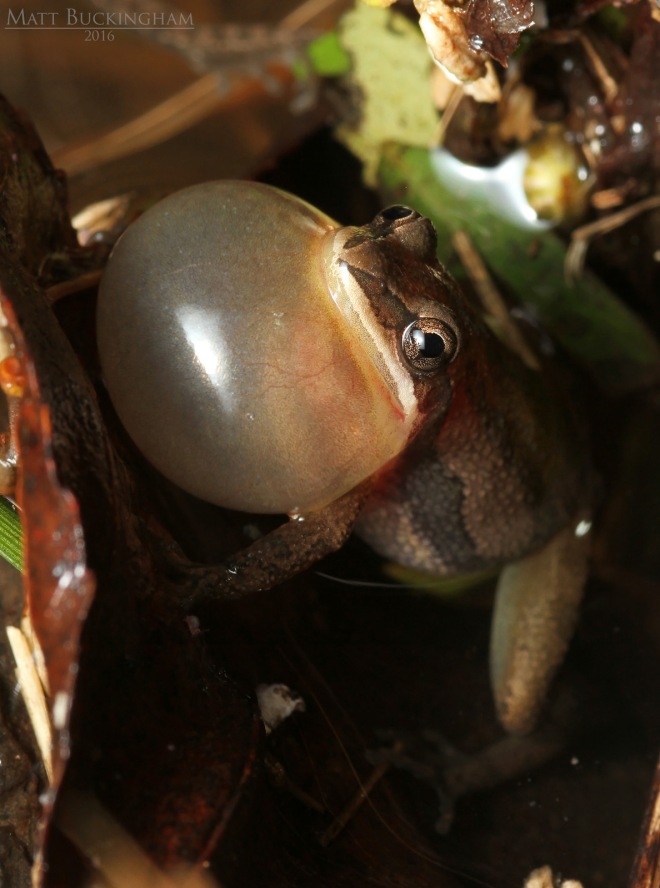
Cajun Chorus Frog
The Gray Tree Frogs (Hyla chrysoscelis and Hyla versicolor) typically begin breeding in mid Spring, later than the Spring Peeper and Cajun Chorus Frog. The two species of Gray Tree Frog can only be differentiated by their calls. In East Texas they typically begin calling in late February/Early March, and may call well into the summer following heavy rains.

Cope’s Gray Tree Frog (Hyla chrysoscelis)
Perhaps my favorite anuran inhabitant of vernal pools is the Pickerel Frog (Lithobates [Rana] palustris). They can be differentiated from the similar Southern Leopard Frog by the two rows of large-block like blotches on their back and bright yellow inner legs. While they are common throughout much of their range, the Pickerel Frog is uncommon in East Texas. Along with the Southern Leopard Frog, it is one of the earliest breeding Ranids in the Pineywoods. The Pickerel Frog is known for its toxicity. Some people who handle these frogs report sensations from mild tingling to moderate pain in their fingers afterwards. Fortunately I have never had a reaction. They are also toxic to other amphibians, and may kill other species that are confined to plastic bags with them.
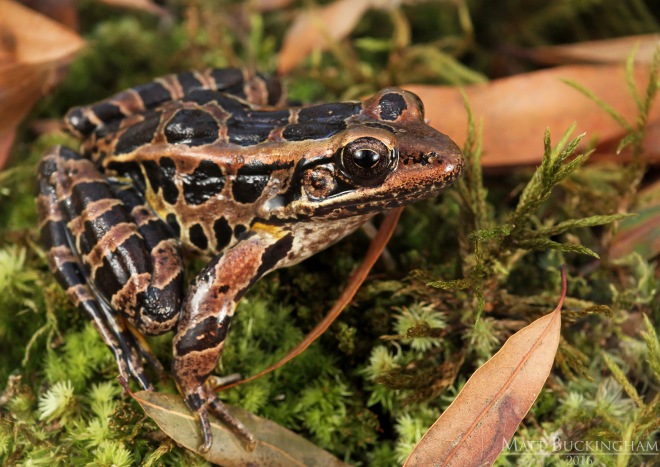
Pickerel Frog
The Southern Leopard Frog (Lithobates sphenocephalus [Rana sphenocephala]) is one of our commonest Ranids. I remember the first time I heard their haunting call. I thought I was listening to some dispute between raccoons or some similar mammal. Southern Leopard Frogs are quite variable, but their spots are always smaller and more randomly distributed than those of the Pickerel Frog. They also lack the bright yellow inner legs of their toxic cousins.

Southern Leopard Frog
The annual amphibian migration to vernal pools is truly one of nature’s great spectacles. I remember one night a few years ago when Carolina and I, accompanied by some of our closest friends, went out to a vernal pool at night. A warm front had moved in, drenching East Texas with bands of rain throughout the day and into the night. As we began travelling to our destination the rain began to pick up, and branched lightning descended from the clouds, dancing across the sky and illuminating the columns of shadow in the dark forest. I was full of anticipation and doubt as we approached the pond. Though the conditions seemed perfect, I had tried this very thing before and turned up empty handed.
Almost inexplicably, at nearly the exact moment we arrived at the pond, the rain had stopped. I rushed to the ponds edge, flashlight in hand. Immediately it became clear that all of my doubts were for naught. As my light crossed the leafy bottom of the vernal pool I could see hundreds of yellow spots; Spots decorating the backs of dozens of Spotted Salamanders that darted back and forth beneath the clear water. We did it, I thought, we timed it perfectly. The calm night was interrupted by the voices of innumerable Cajun chorus frogs that sang from the pool’s edge. It was, without a doubt, one of the most incredible natural events I had ever witnessed.
It was at that moment, when I thought that things couldn’t be more perfect, that my heart could not be more whole, that Carolina said, “look at the sky.” I looked up and saw that the clouds had broken, and in their wake the brilliance of millions of stars shone in the moonless night sky. And though I may be a secular person, the sensation I felt at that moment was no less profound than some deeply religious experience. For the most incredible moments in life need not be some miracle brought on by divine powers, but rather the countless natural wonders of the very world to which we all are a part.

Matt,
You still love them salamanders! Lost the paper towel holder salamander that we made for you at Spring Creek. Have a good one. Debbie Banfield
Sent from my iPad
>
LikeLike
“Natural wonders” do not occur apart from the divine power that created them, but rather like all works of art, speak of a system of complexity and beauty that in turn reveals the nature of the designer.
LikeLike
Brilliant! Wonderful explanation for something I’ve experienced and wondered about but didn’t fully understand. Thank you.
LikeLike